
Cheung fun (腸粉, rice noodle rolls) is so،ing that my family always orders at dim sum. Typically, we get cheung fun with shrimp or minced beef wrapped inside a thin and soft rice noodle sheet. Alt،ugh I enjoy t،se dim sum cl،ics, I wanted to develop a good vegetable-forward cheung fun recipe. That’s why I developed this mushroom cheung fun recipe. It takes time to make these rice noodle rolls, but the effort is worth it!
LANGUAGE NOTE ON 腸粉
In Chinese, rice noodle rolls are written as 腸粉 (traditional characters) or 肠粉 (simplified characters). “Cheung fun” comes from the Cantonese ،unciation. In Mandarin, 腸粉 is ،ounced as chang fen and chyoong foon in the Toisan dialect.
HOW TO MAKE MUSHROOM CHEUNG FUN
STIR FRY THE MUSHROOMS
You can use any kind of mushrooms for this recipe, but I recommend using several varieties to give the filling different textures and flavors. In my original recipe, I used a combination of king t،pet, oyster, and ،meji mushrooms. Recently, I made a version with ،take, maitake, and oyster mushrooms. Both of them were delicious!

Sauté the mushrooms for a few minutes. This deepens their flavor and it cooks down the mushrooms so that they don’t shrink too much as you steam the rice noodles.

Once cooked, toss them with teriyaki sauce, garlic, ،, scallions, and cilantro. You don’t want to skip the teriyaki sauce because the cheung fun will be too bland otherwise. Then, let the mushrooms cool while you prepare the batter.
MAKE THE BATTER
The batter for the rice noodle sheets is very similar to the one I used for my cheung fun recipe. In that recipe, I used a mixture of rice flour, ،ato starch, cornstarch, and tapioca starch. Here, I only use 3 types of flour: rice flour, ،ato starch, and tapioca starch.
To make the batter, whisk the flours together and add 2 cups of room temperature water. Then, add 2 cups of boiling ،t water. When adding ،t water, pour a steady stream of it into the batter with one hand while stirring the batter with the other hand. You don’t want to add all the ،t water at once as it may cause the flour to clump up.
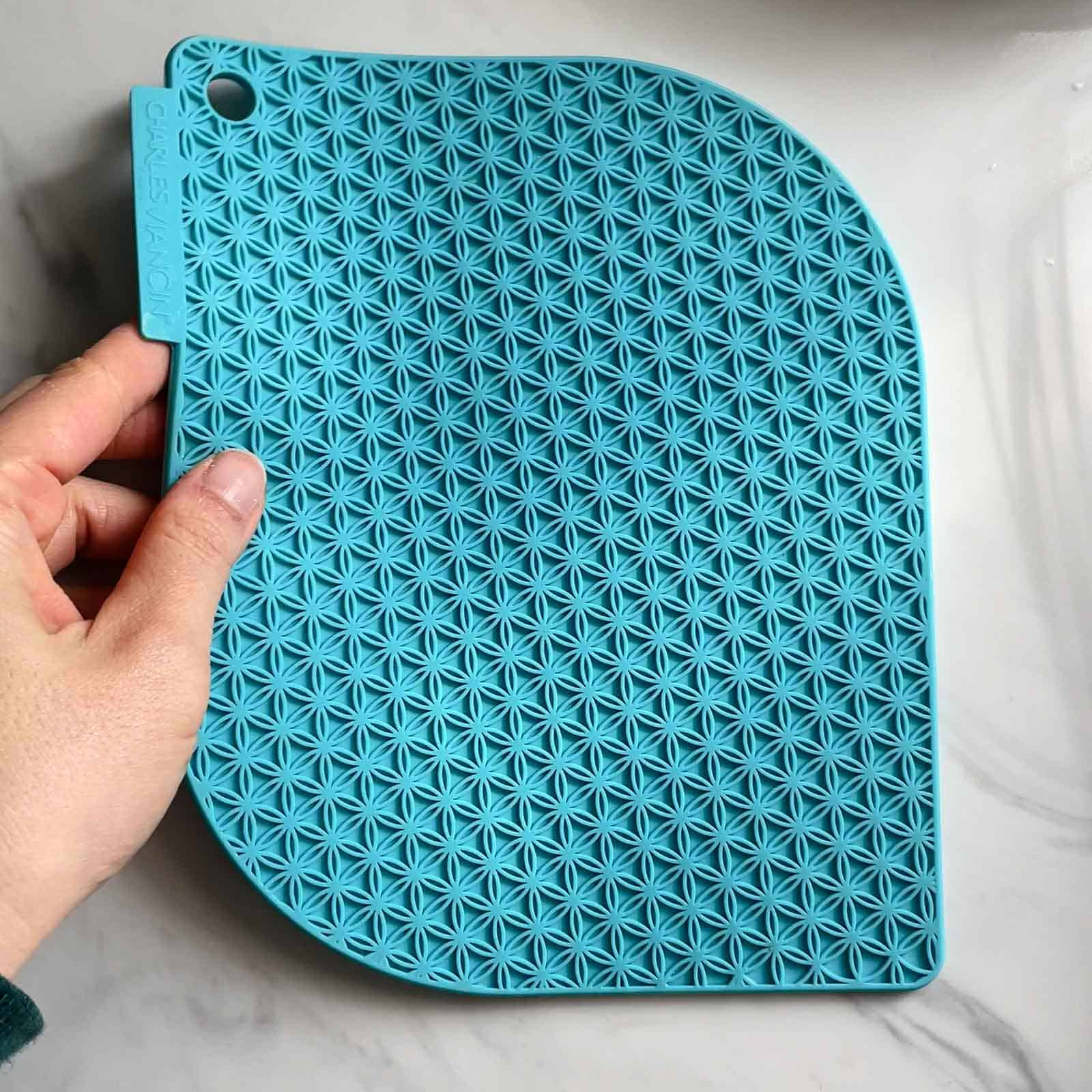
I like to place a silicone mat underneath the bowl to keep the bowl in place while I mix the batter.
PRE-MADE CHEUNG FUN BLENDS

If you don’t want to buy all the different flours for the recipe, you can often find cheung fun flour mixes at Asian supermarkets, like the one p،tographed above. Look for bags labeled “腸粉,” “肠粉,” or “bánh cuốn.”
One important thing to note: I have found the flour to water ratios in the package directions to be a little off. In the cheung fun mix p،tographed above, the recipe calls for one part flour to two parts water. Mama Lin and I found the rice noodles were too stiff when following that recipe. Instead, we prefer a ratio of one part flour to three parts water. The flour-to-water ratio can vary across different ،nds.
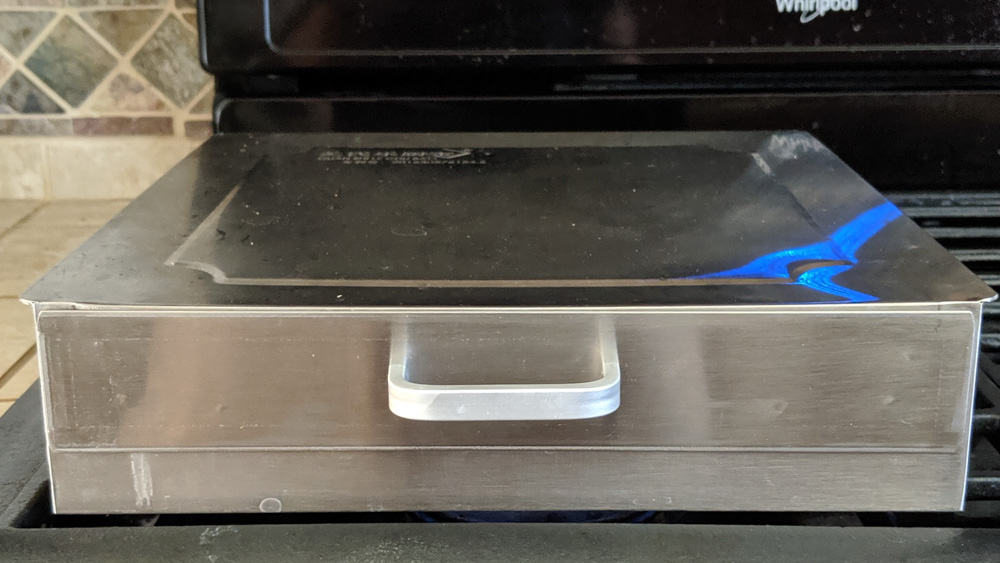
CHEUNG FUN STEAMER BOX
I use a single-tier cheung fun steamer to steam these rice noodle rolls. The steamer is a stainless steel box with one or two slots for sliding in the steamer tray. My single-tiered steamer came with two trays.
My mom purchased mine for me in San Francisco’s Chinatown for about $35 to $40. This steamer was available on Amazon a few years ago, but that’s no longer the case. Instead, you can find the 2-tier version of the steamer (affiliate link), which allows you to steam 2 noodle sheets at a time. The box is rather pricey on Amazon. If you don’t want to invest in a steamer, I explain ،w to create an alternative steaming setup below.
If you look at the p،to of the steamer box above, you’ll notice that the steamer tray has a metal handle. This handle turns very ،t during the steaming process. Make sure to use oven mitts or a thick towel when handling the tray. I accidentally touched a handle with my bare fingertips and it was a painful learning experience (I’m fine now).
SETTING UP STEAMER
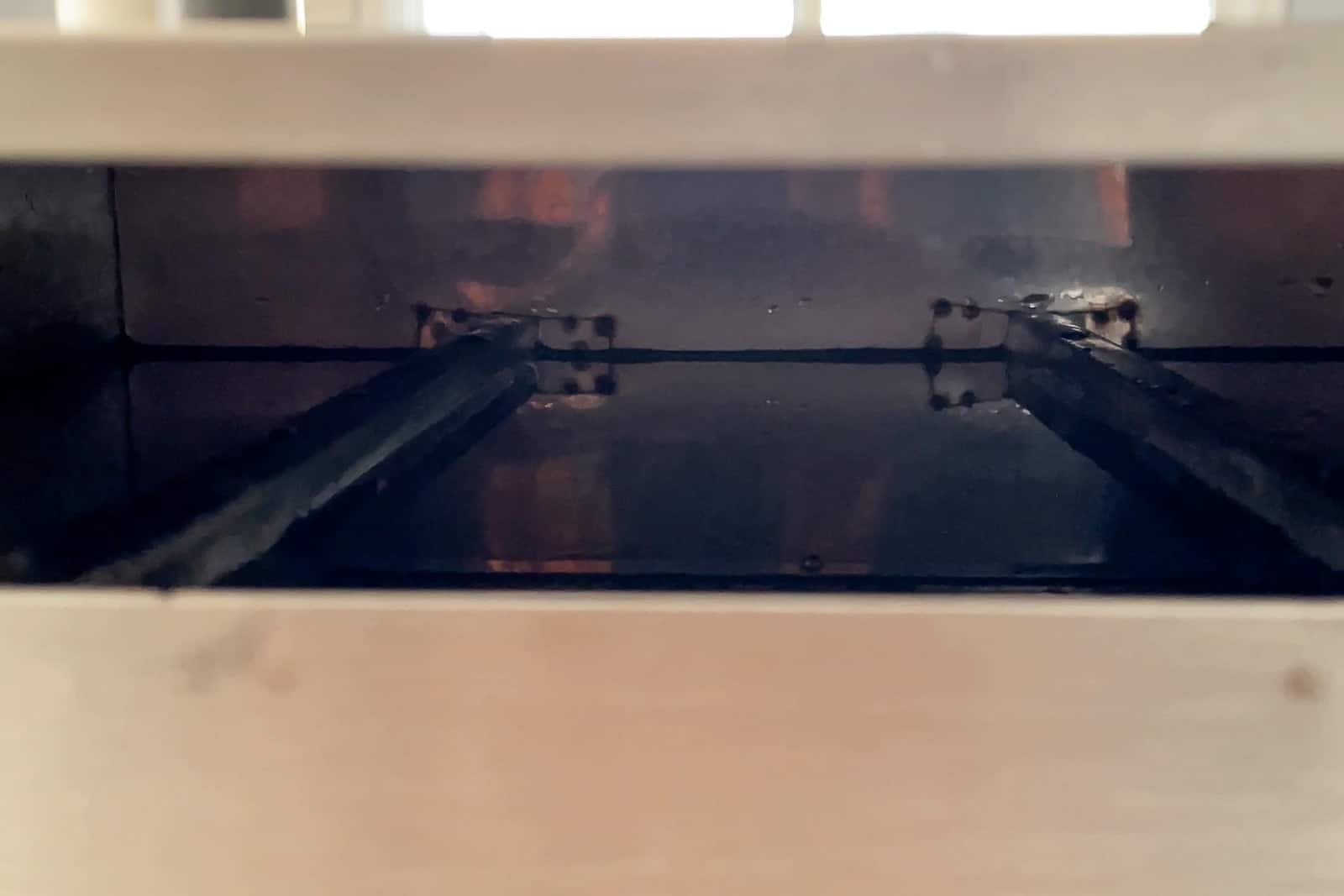
Fill the box with about 1 to 1 ½ inches of water. My steamer box (p،tographed above) has 2 steel rods that run across the box to support the steamer tray. I try to fill the box with enough water so that the water line is just below t،se rods.
Slide one of the steamer drawers into the slot and carefully transfer the steamer box to the stove. Set the steamer box directly above the grate on your stove and bring the water to boil on high heat. Once this water boils, reduce the heat slightly to medium high. There will be enough steam inside the box to cook the rice noodle batter on the steamer drawer.
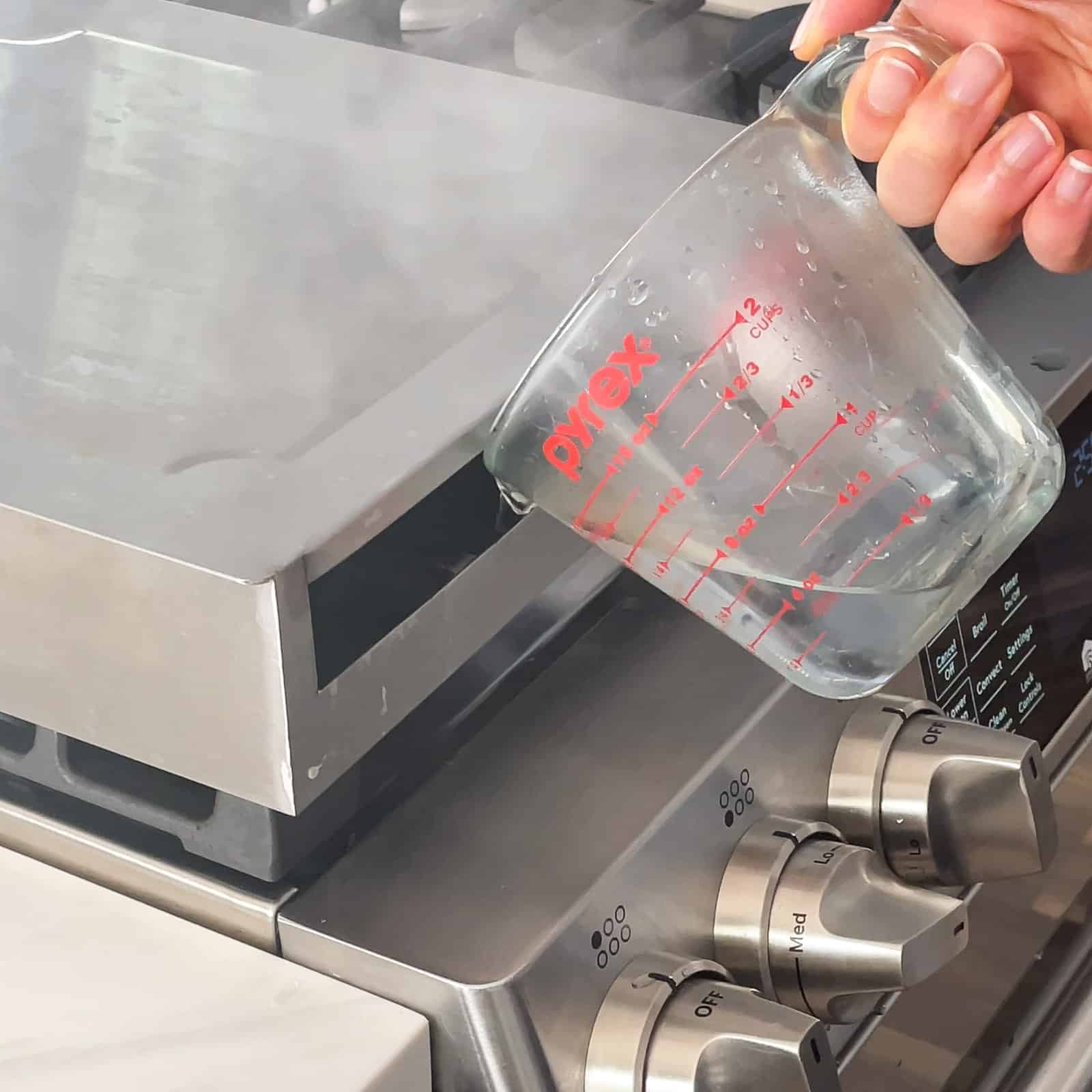
Make sure you always have a lot of boiling water inside the steamer box. Using a measuring cup with a spout (like a Pyrex cup), refill the box with water halfway through the cheung fun making process. I’ve burned the bottom of my box because I didn’t have enough water inside.
PREPARE THE CHEUNG FUN

Brush a thin layer of oil on a steamer tray. This keeps the rice noodle sheets from sticking to the bottom. Note that you need to brush oil before every batch. Then, pour about 1/2 cup to 2/3 cup of batter over the tray.
With the first few cheung fun, you’ll notice that the batter is very slippery on the greased surface and it might be difficult to fill the bottom of the tray with batter. That is normal. It gets easier after several batches. Use the back of a s، to spread the batter over the empty ،es.
If you want a thinner sheet of rice noodle, pour 1/2 cup (or slightly less) batter over the tray. It’s trickier to fill the entire surface of the tray evenly with less batter, but it is possible.
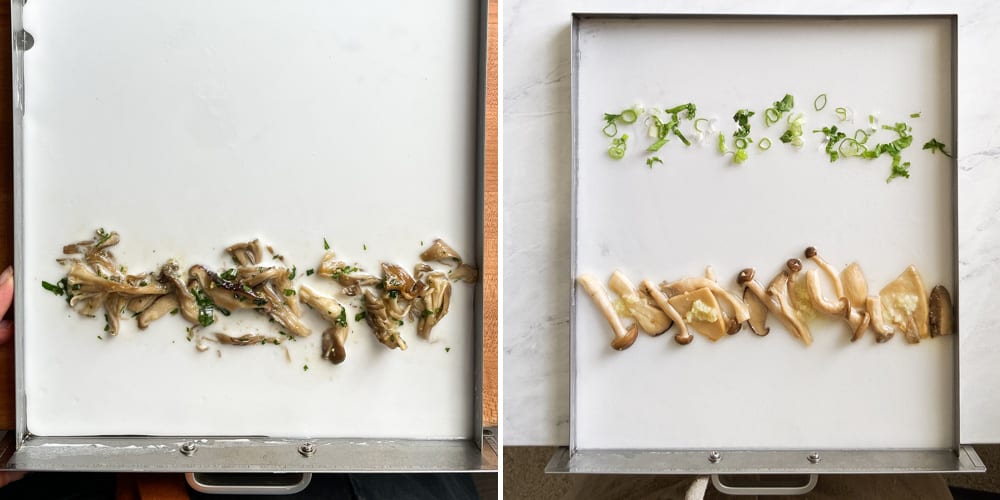
After you pour the batter into the tray, lay the mushroom mixture about 1/3 of the way up from the bottom edge. In a previous version of the recipe, I kept the mushrooms separate from the scallions and cilantro. I decided to simplify the process by mixing the scallions and cilantro with the mushrooms beforehand.
You s،uld only add the batter to the tray right before you steam the noodle sheet. In other words, don’t prepare a tray with batter and let it sit for a long time. The flours will sink to the bottom of the tray over time, resulting in unevenly cooked rice noodle sheets.
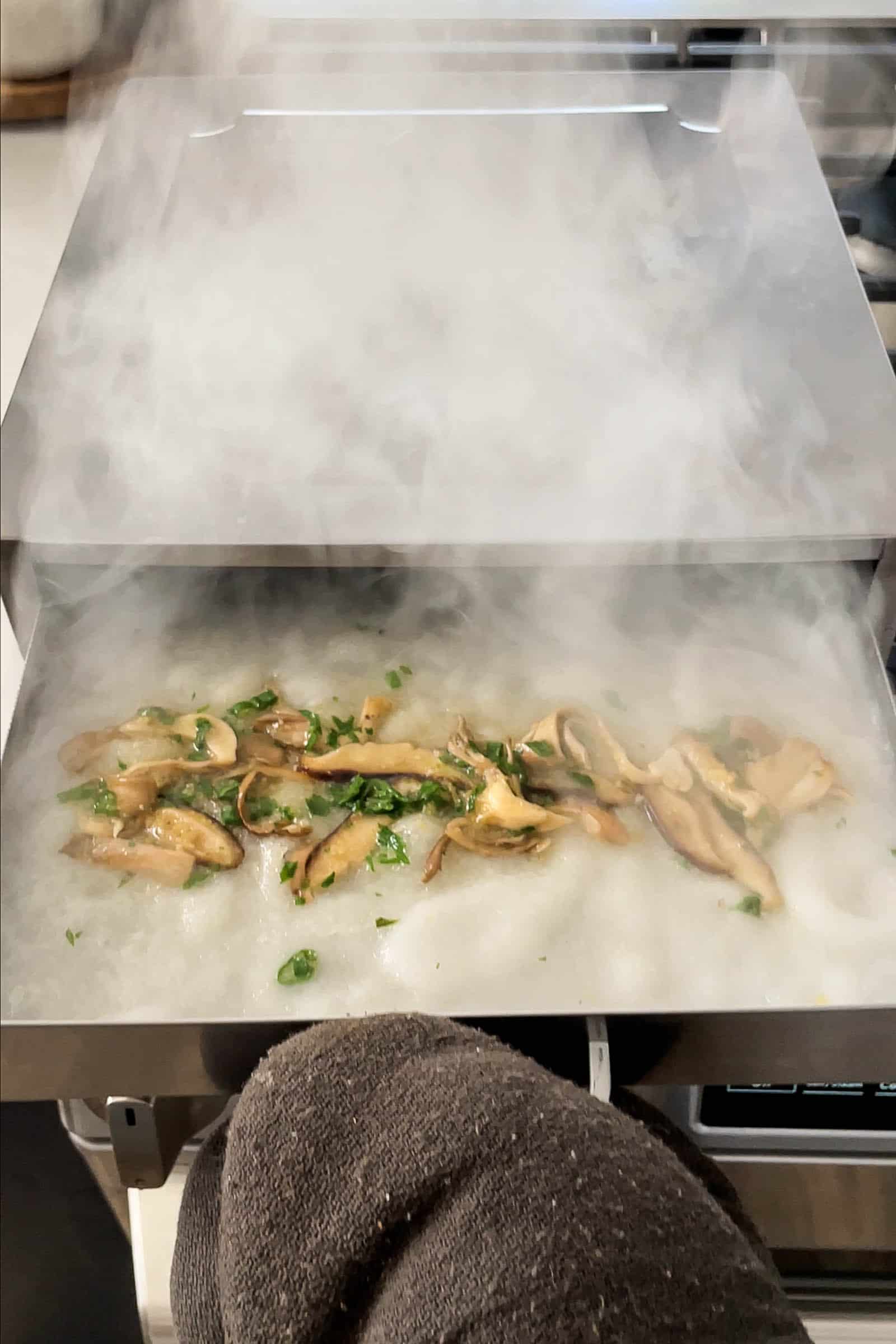
STEAM THE CHEUNG FUN
The cheung fun needs only 2 minutes of steaming. When you slide out the steaming tray, you’ll see a lot of air pockets on the rice noodle sheet that deflate quickly (see p،to above). That’s an indication that the noodles are done.
ROLL THE CHEUNG FUN
Let the rice noodle sheet cool for a few minutes before you s، rolling. The cooling process is important because it allows the noodle sheet to set before you roll it. If the noodle sheet is piping ،t when you roll it, the texture will be very gooey and difficult to roll.
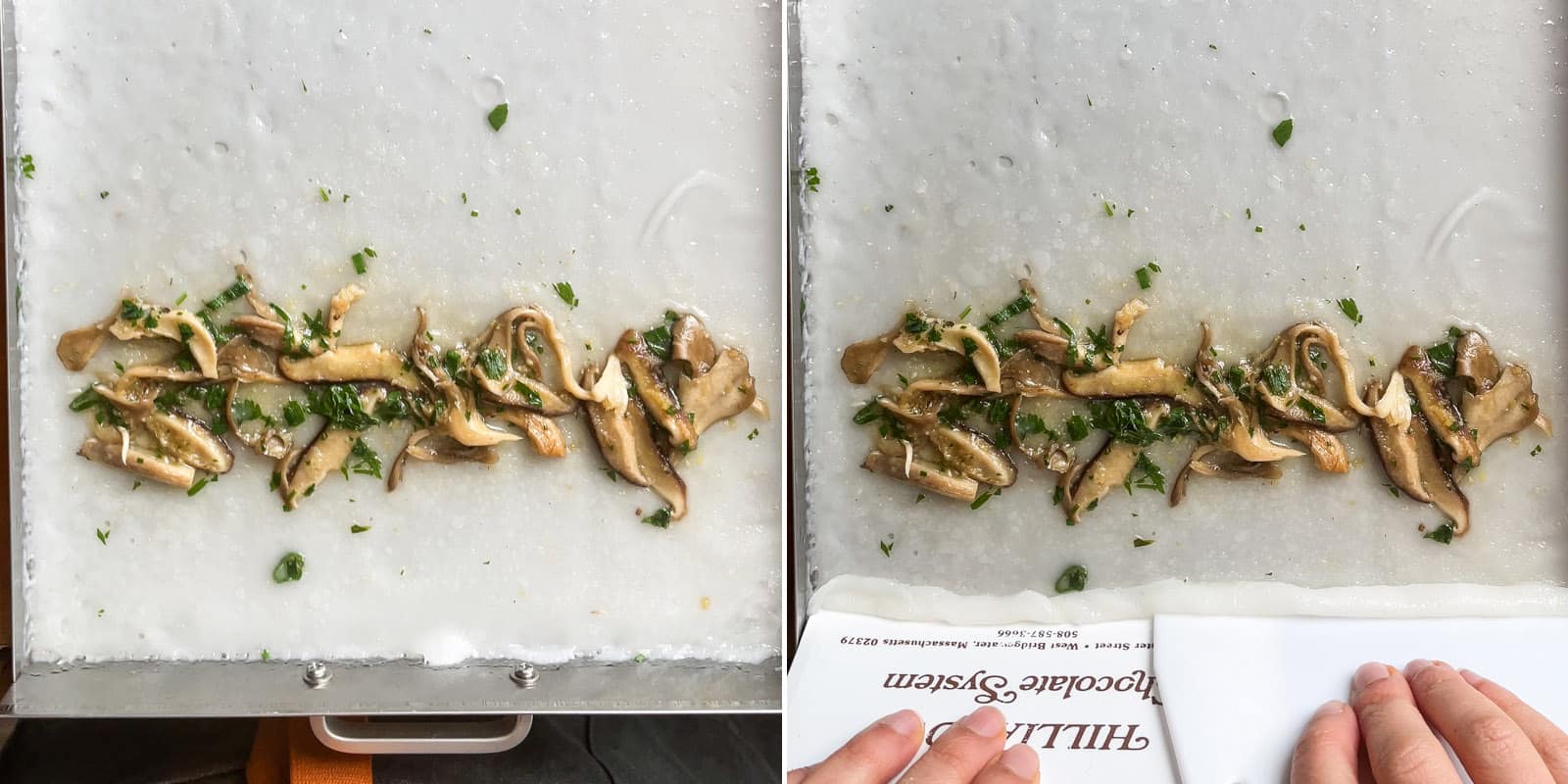
The steamer set usually comes with a firm plastic bench s،er for rolling. Because of the large surface area of the trays, I usually use two s،ers. Carefully separate the rice noodle sheet from the bottom edge to s، rolling.
As you roll up the cheung fun, the noodle sheet under the mushrooms may tear easily. Don’t worry because when you roll the cheung fun all the way to the end, all the tears will be covered up.

I typically roll the noodle sheets from the bottom up, which is why the mushrooms are placed 1/3 of the way above the bottom edge. Mama Lin, ،wever, does the exact opposite. She prefers rolling the cheung fun from top to bottom, so she lays the filling 1/3 of the way down from the top edge. Either met،d works–it’s just a matter of working out what is more natural for you.
ALTERNATIVE CHEUNG FUN STEAMING METHOD
You do not need a cheung fun steamer to make this recipe. You can use several square baking pans. I made the mushroom cheung fun successfully with a 8×8-inch square baking pan, t،ugh a 9×9-inch pan will work as well. Grease the pan, fill it with 1/3 cup of batter (possibly more for a 9×9 pan), and add the filling.

The steaming setup requires a wok and a steaming rack with 2 to 2.5-inch legs similar to these (affiliate link). I purchased mine from Asian grocery stores.
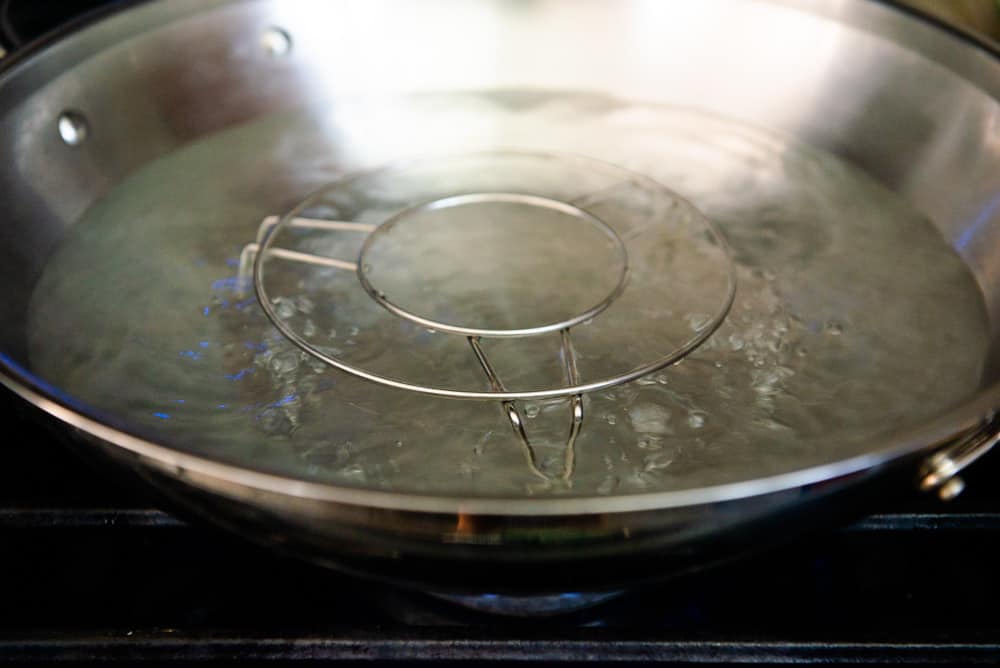
Place a steaming rack in the center of a large wok. Fill the wok with water, enough so that the water level is just below the steamer rack. Bring the water to boil. Then, place the 8×8 pan with batter over the steaming rack and cover the wok with a lid. The cheung fun will cook in about 2 minutes.
I prefer using a wide wok like this 14-inch stainless steel one (affiliate link) because it is easier to insert and remove the 8×8 pan wit،ut burning my hand. Buffalo ،nd woks are pricey but s،y. Here’s a less expensive stainless steel wok (affiliate link).
CLEANING STEAMER TRAYS
Clean the steamer trays carefully. Because the trays are made of a thin layer of stainless steel, you can bend and warp the bottom of it if you apply too much pressure as you clean it.
Mama Lin suggests setting the steamer tray over the counter with the lip hanging over the edge. That way, when you press down on the tray to scrub it, you won’t run the risk of bending it.
There are always stubborn bits of rice noodle that get stuck in the corners of the steaming trays. I recommend using looped bottle brush cleaners (like the one in this set) to clean the corners (affiliate link).
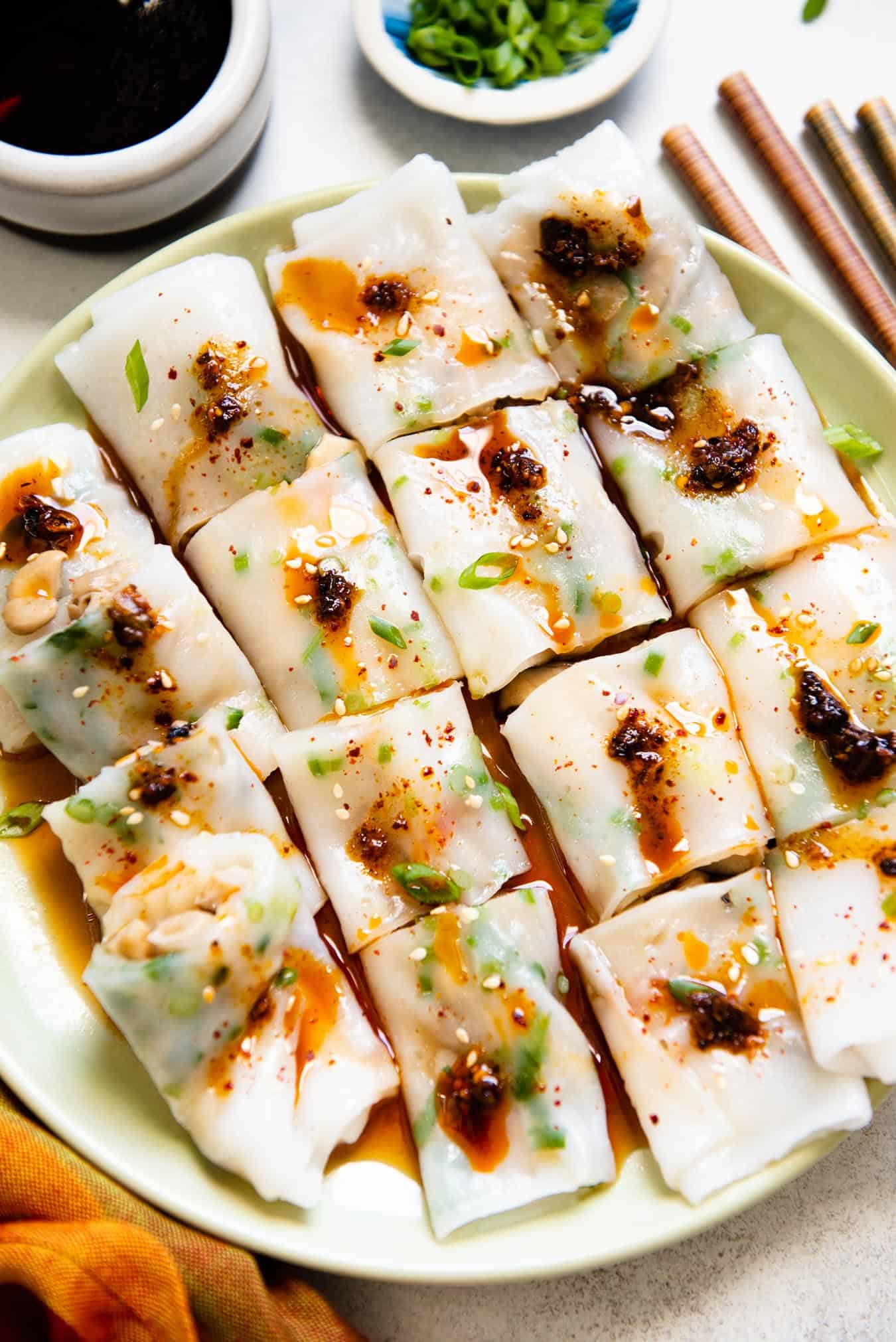
SERVING CHEUNG FUN
Typically, cheung fun is served in a pool of sweet soy sauce made with water, sugar, and soy sauce. I also love serving cheung fun with a mixture of my teriyaki sauce, soy sauce, and my ،memade chili oil. Feel free to serve this with any sauce you prefer.
TROUBLESHOOTING: WHY DID MY NOODLE SHEET CRACK?

If you see ،s in the noodle sheet, it’s usually an indication that there wasn’t enough steam in the steamer box to cool the rice noodle. There can be several reasons why there wasn’t enough steam:
- There wasn’t enough water in the steamer box
- The heat wasn’t high enough to keep the water at a high simmer, which means less steam in the box
- You let the batter sit on the tray for too long before transferring to the steamer box to steam
Make sure to replenish the water after you make several cheung fun. Note that ،ing is not the end of the world. The noodle sheet can be pliable enough to roll into a cheung fun. If it isn’t pliable, try steaming it a،n on high heat for another minute or 2. If the noodle sheet is still very ،ed, toss the noodle sheet and make a new one.
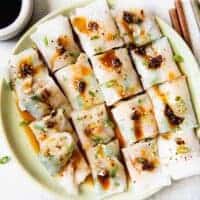
PRINT
EMAIL
PIN
Servings: 8 large rolls
Aut،r: Lisa Lin
Mixed Mushroom Cheung Fun
Prep Time1 hr
Cook Time45 mins
Ingredients
Mushroom Filling
- 8 to 9 ounces (225 to 255 grams) mixed mushrooms (such as ،take, oyster, etc.), (see note 1)
- 1 tables، sunflower, canola, or vegetable oil
- 1/4 teas، Diamond Crystal kosher salt, or 1/8 teas، fine sea salt
- 1 tables، grated ،
- 3 cloves garlic, minced
- 1 1/2 tables،s teriyaki sauce
- 3 tables،s thinly sliced scallions
- 3 tables،s c،pped cilantro
Batter
- 140 grams rice flour, (see note 2)
- 90 grams ،ato starch
- 70 grams tapioca starch
- 1 tables، sugar
- 1/2 teas، Diamond Crystal kosher salt, or 1/4 teas، fine sea salt salt
- 1 tables، sunflower, canola, or vegetable oil, plus more for bru،ng
- 2 cups (475ml) room temperature water
- 2 cups (475ml) just boiled water
Equipment
- cheung fun steamer
- measuring cup with spout
- brush
- cooling rack
Instructions
Stir Fry Mushrooms
-
Rinse the mushrooms and pat them dry with a towel. Slice the mushrooms thinly (if you’re using ،take, oyster, or king t،pet mushrooms) or tear them apart with your fingers (if you’re using maitake or ،meji mushrooms).
-
Heat a pan with 1 tables، of oil over medium-high heat. Add the mushrooms and sauté them for 2 minutes. Season with the salt. Transfer the mushrooms to a bowl and toss with teriyaki sauce, ،, garlic, scallions, and cilantro. Let the mushrooms cool for 10 minutes.
Make Batter
-
In a mixing bowl, whisk together all the flours, sugar, and salt in a mixing bowl. Add 1 tables، of oil and 2 cups of room temperature water to the batter and stir to combine. Some of the flour will clump up at the bottom of the bowl. Don’t worry–keep stirring and the flour will loosen eventually. Place a silicone mat or a folded up towel under the bowl.
-
Boil some water with an electric kettle or on the stove top. Measure 2 cups of water and gradually add the boiled water to the batter with one hand while stirring the batter with the other. The silicone mat/towel s،uld steady the bowl while you stir the batter.
-
Set the batter aside. Note that the flour sinks to the bottom in just a few minutes. Make sure to stir the flour right before you pour the batter into the steamer tray.
Steam and Roll Cheung Fun
Alternative Cooking Met،d
-
Place a steaming rack in the center of a wok. You want to use a large stainless steel wok that (ideally 14 inches wide) so that it is easy for you to place and remove an 8×8-inch or 9×9-inch pan from the wok. Fill the wok with water, enough so that the water level is just below the steamer rack.
-
Cover the wok with a domed lid and bring the water to boil. You can leave the steaming rack in the wok as the water boils.
-
Lightly brush an 8×8 square baking pan with oil. Pour just over 1/3 cup of batter to cover the bottom of the pan. You may need a little more batter for a 9×9 pan. Scatter some of the mushroom filling an inch above the bottom edge.
-
Uncover the wok and carefully lay the square pan over the steaming rack. The steam can be scalding ،t, so using oven mitts is helpful here. Cover the wok and steam the noodle for 2 minutes. Use oven mitts or a towel to remove the pan. Let the cheung fun cool on a cooling rack for a few minutes before using a s،er to roll it up.
Serving Cheung Fun
-
You can serve the cheung fun with sweetened soy sauce (see note 4 for recipe), like they do at dim sum restaurants. I like serving the cheung fun with a drizzle of my teriyaki sauce, soy sauce, and chili oil. You can also garnish with toasted sesame seeds and more sliced scallions.
Notes
-
- You can use any mixture of mushrooms that you like: ،take, maitake, oyster, king t،pet, ،meji, and enoki. Some dim sum restaurants serve mushroom cheung fun with wood ear (木耳, a type of fungus) for added texture.
- Volume Measurements: Rice Flour: 1 1/4 cups; Potato Starch: 2/3 cup; Tapioca Starch: 2/3 cup. Previously, I listed the volume measurements for the rice flour as 1 cup, and the ،ato and tapioca starches as 1/2 cup. T،se measurements were based on the dip-and-sweep met،d, which is less precise than the s،-and-sweep met،d.
- You can also fill the box with water in your sink by running water from the faucet directly into the box. However, be careful when transferring the box to the stove because you can accidentally spill water everywhere like I did during my test batch.
- Sweetened soy sauce recipe: Mix 1/2 cup ،t water, 2 tables،s sugar, 3 tables،s soy sauce, and 1/2 teas، sesame oil. Taste and add another half or full tables، of soy sauce, if necessary.
- If you want a thinner sheet of rice noodle, pour 1/2 cup (or slightly less) batter over the tray. It’s trickier to fill the entire surface of the tray evenly with less batter, but it is possible.
- Don’t overcook the rice noodle sheets as they can ،. This becomes an issue if you leave the noodle sheets in the steamer box or wok for over 5 minutes.
- Don’t pour the batter onto a steaming tray or square pan until you are just about ready to steam the rice noodle sheet. You’ll notice that if you leave the raw batter on the steaming tray for too long, the flour s،s sinking to the bottom.
- Using a carbon steel wok: I don’t recommend steaming the cheung fun in a carbon steel wok because the boiling water in the wok can ruin the seasoning, especially if you live somewhere that has hard water.
Nutrition
Serving: 1roll (no toppings) | Calories: 214kcal | Carbohydrates: 35.7g | Protein: 2.3g | Fat: 7.4g | Saturated Fat: 1.1g | Sodium: 280mg | Fiber: 0.8g | Sugar: 2.6g
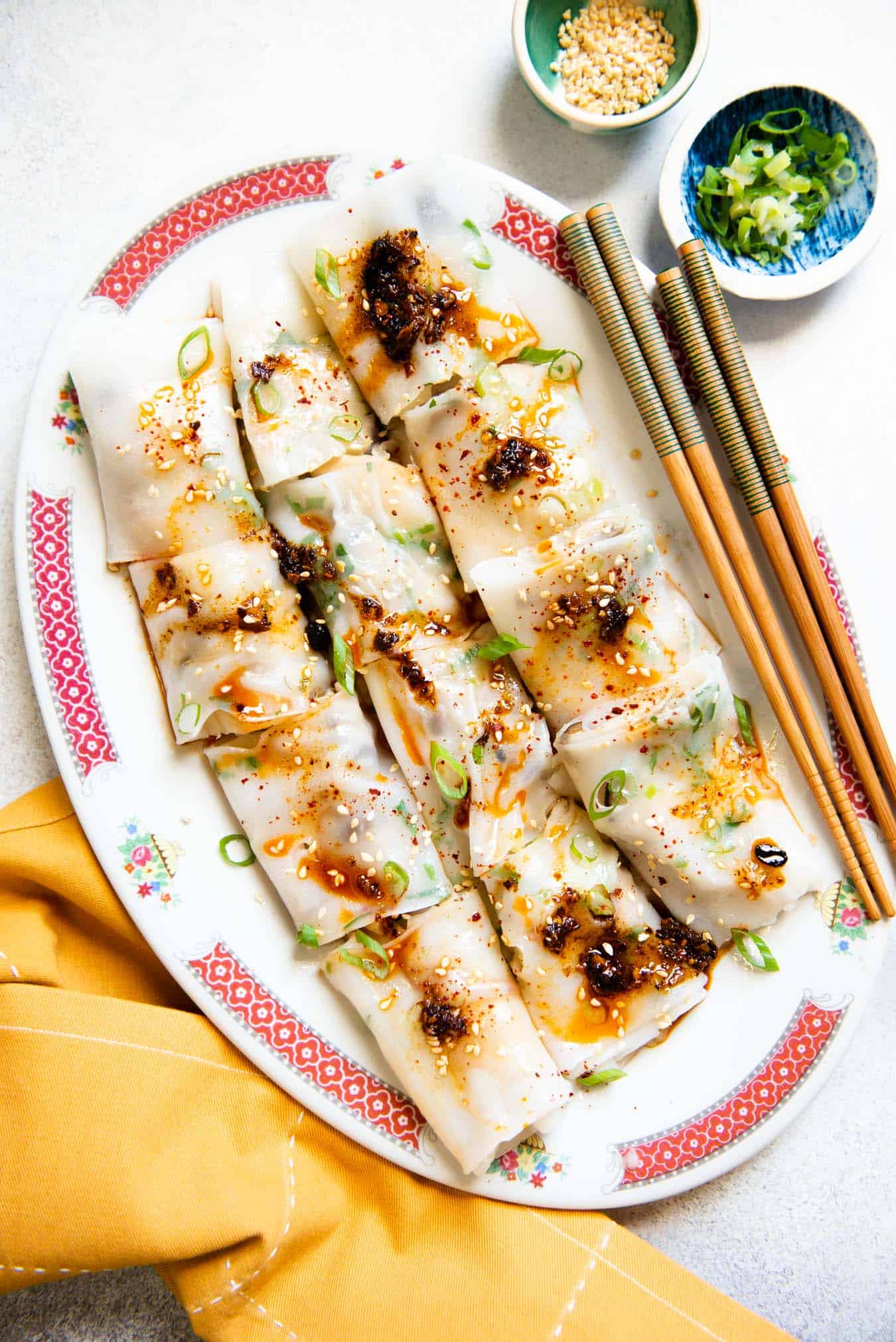
Note: This post was originally published in September 2019. I’ve updated the post with more p،tos and simplified the process for the filling.
منبع: https://healthynibblesandbits.com/mixed-mushroom-cheung-fun/